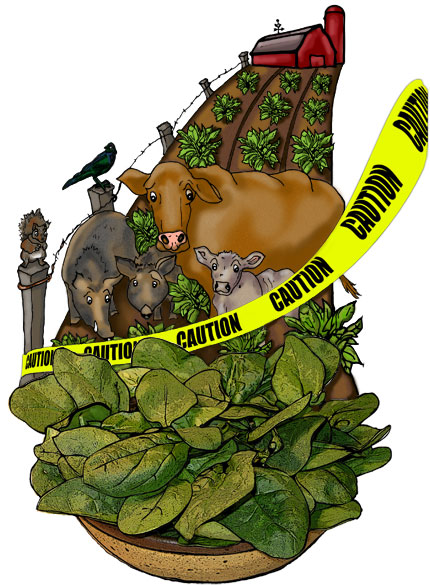
Squinting out from behind square glasses, Dick Peixoto pulls his pickup truck off the highway and onto Santa Maria Ranch. He drives past tractors, bee hives, and cactuses to park on a muddy side road. Immaculate fields of cauliflower, strawberries, and raspberries stretch to the beige-colored foothills. "You see those dots over there?" he asks, pointing at the mountains. "Those are all cattle. You'll notice the farmland goes right up against the hill."
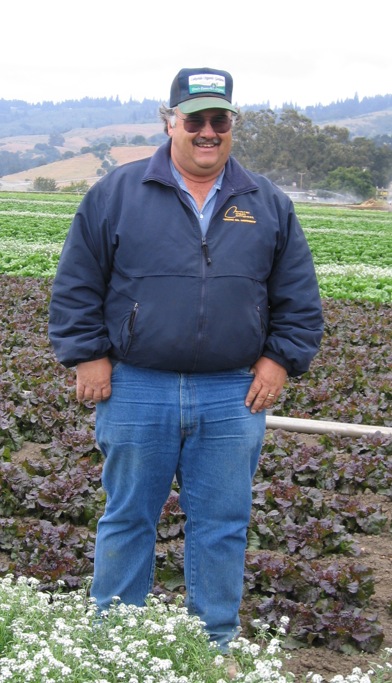
Dick Peixoto standing among lettuce and chard.
Peixoto's plot is in a precarious position, one shared by hundreds of growers in this fertile valley near the central California coast. From here in Watsonville to King City, more than 80 kilometers south, produce farms lie in cozy proximity to cattle-grazing land. Even though farmers are aware of the risk, the area has become a major source of vegetables contaminated with E. coli O157:H7, a nasty bacterial strain that can wreak intestinal havoc in humans. Of the 22 outbreaks since 1995, nine have been traced to farms in this region. Even worse, the problem seems to be spreading.
Despite the threat to public health, scientists still do not know how E. coli O157:H7 make it from their native environment, the bellies of farm animals and wildlife, to our dinner plates. In 2006, scientists used DNA fingerprinting to trace the E. coli from September's "spinach scare" back to the Salinas Valley farm where the bugs entered the food system. Now they're preparing to use those same techniques and massive environmental sampling to work on a far more difficult detective story: finding out how the bacteria get to fields in the first place. If they are successful, the results could change the design of produce farms and may spur regulators to place more restrictions on cattle ranchers and dairy farmers.
"Hopefully we can figure out which animals and which transports are responsible so we can stop this bloody thing from happening," says epidemiologist Rob Atwill, a water-safety expert at the University of California, Davis. "Right now, it's a big mystery."
Troubled landscape
Peixoto's 32 rental plots cover 1200 acres, and the geography of each one is different. He says his employees work hard to keep the vegetables safe. They have dug deep ditches to divert water that runs off the foothills and might carry tainted manure. Peixoto pays a company to test his fields and the lake water he occasionally uses to irrigate his crops. He tells his workers to wash their hands. He's proud of his efforts; his mesh baseball cap, bearing the company logo and the slogan "Don't Panic! It's Organic!", reflects his commitment to producing safe food.
Still, when it comes to bacterial contamination, some things are out of his hands.
For instance, the ditches may divert runoff in most cases, but not every time. "If it rains cats and dogs, if it's really a gusher, you might blow those ditches and it might move into the field," says Atwill. If that happens, Peixoto might have to scuttle the season's crop. But no federal regulations mandate that farmers dispose of crops after flooding. He might send samples to the laboratory to test for contamination, but there is no guarantee that a negative sample means the entire field is clean.
Flooding isn't necessarily the most likely source of contamination. Theories abound: Birds, ground squirrels, raccoons, and wild pigs could easily carry cow manure in from a field, or their own droppings may contain the bacteria. Dust, field workers, and farm equipment may be to blame, tracking in and spreading the bug.
"We're not farming in a laboratory. This is not a sterile environment," explains Peixoto, turning his truck around and out of the mud. It could take as little as a tractor running over manure and spreading it through the field, he says. "All it takes is one bad day."
A sticky problem
Such a day happened in fall 2006, when the United States experienced the worst known E. coli outbreak linked to leafy greens. Three deaths and more than 200 illnesses were reported to the U.S. Centers for Disease Control and Prevention, but the actual number of people infected may be closer to 4000. Although investigators traced contaminated spinach bags back to a farm near Salinas, the troublesome E. coli strain was elusive.
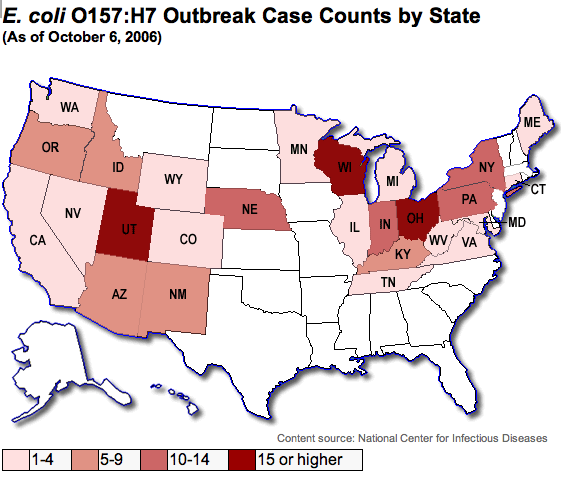
After a lengthy search, scientists eventually isolated the same strain from cow and pig feces, water, and dirt in sites roughly a kilometer from the nearest spinach field. Officials at the California Department of Health Services think wild pigs broke through fences surrounding a plot, tracking feces in with them. Cow dung is the likely culprit. In January, researchers at the University of Tennessee found E. coli O157:H7 in more than 3 percent of beef and dairy cattle and in almost 9 percent of domesticated pigs. No one knows how common it is in wild pigs.
Finding the source of E. coli O157:H7 in produce before it lands in grocery bags is important to growers, because there is no surefire way to eliminate the bacteria. At the processing stage, where packagers usually treat greens with chlorine bleach, the bacteria can still stick. Preventing contamination is more critical for organic growers. Peixoto is limited to using water with 3 parts per million of chlorine to wash vegetables. Food sanitation experts call for water with a chlorine concentration of at least 10 to 15 parts per million; the federal limit is 200 parts per million. Experts say an effective concentration would have to kill more than 90 percent of all types of bacteria on the vegetable's surface.
But pinpointing the source of contamination is not easy. To date, no one has reported a single cell of E. coli O157:H7 on plants in a field. Robert Mandrell, who leads the Produce Safety and Microbiology Research Unit of the Agricultural Research Service at the U.S. Department of Agriculture (USDA), is not surprised. "E. coli is everywhere. We all carry it, it's a very common bacteria," he says, but the O157:H7 strain is far rarer. Testing the same part of a river twice in a minute can give different results. This rarity does not make the bug any less virulent, however. Unlike Salmonella, which can require hundreds of thousands of cells to infect a person, E. coli may need as few as ten.
Mysterious transport
Two years ago, Mandrell and his USDA colleagues partnered with the State of California to do some routine field testing. He wound up finding out just how tricky it was to catch E. coli O157:H7 on farms. Sitting in his office in Albany, California, near Berkeley, he pulls up a picture of a plot with two rows of lettuce leading off into the distance, a muddy irrigation ditch in the foreground.
"This property was associated with three outbreaks. We did find a positive right there," he says, pointing to patch next to an irrigation ditch. Then he points to the lettuce. "Zero from there, zero from the soil, zero from compost that was put on this, zero from wildlife feces. So the water became interesting."
The finding led Mandrell's group to sample water in rivers and streams in the Salinas Valley region. Last year, during the spring rains, more than half of the 23 sites tested positive for the bug. His laboratory matched strains from streams by cattle ranches to rivers close to the sea, showing that E. coli can survive in and spread through water. They found identical bacteria, separated by as much as 32 kilometers and 8 months. E. coli was a hardy traveler, he concluded.
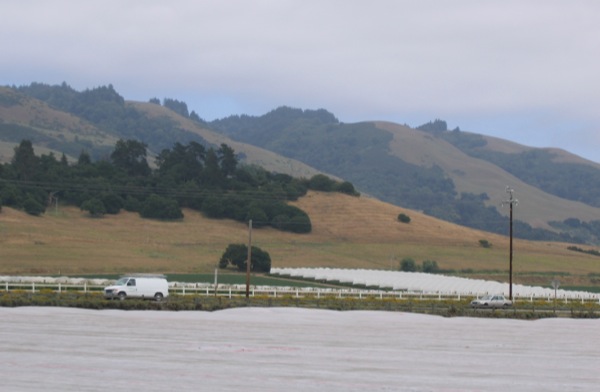
A strawberry field in Watsonsville, Calif.
But there were problems the study failed to answer. Farmers in Salinas frequently grow three harvests of lettuce. While the E. coli–laden water was found in March and early April during the first harvest, last year's spinach outbreak—and almost all of the other outbreaks related to leafy greens—occurred in the fall during the last harvest. Mandrell suspects the bacteria infiltrate an area with the rains, which dilute and spread them. Then high temperatures in July and August may encourage the E. coli to multiply. But he can't be sure. "This is all speculation, but this is what we do. We speculate until we get statistics," he says.
Mandrell is joining forces with Atwill and other UC Davis scientists to look for a clear chain of events that leads to bacterial contamination. Together they will expand the search beyond water. Over the next four years, they will collect, dilute, and culture thousands of soil, fecal, water, and vegetable samples—3200 of each.
The process will be more than a bit touchy. Growers worry that if samples come up positive, the results may be subpoenaed later. Still, Mandrell is confident the team can negotiate access, even if it means the study must be double-blind: Neither the scientists nor the farmers would know the exact results and locations of the E. coli O157:H7 tests.
If the team managed to find E. coli O157:H7 on a field and in an adjacent stream, they still would need to prove a connection. To do this, they will look for tell-tale genetic copying errors. E. coli DNA has 4 million bits of code along its length, like molecule-sized teeth on an extra-long zipper. Sometimes when E. coli divides to make a copy of itself, the zipper mechanism sticks and certain segments get repeated. These errors are rare, says Mandrell, but they still arise often enough to distinguish between sibling strains of E. coli O157:H7 and distant relatives. Mandrell's laboratory uses ten sections in the DNA of E. coli where these hiccups commonly occur to identify a strain.
Still, the likelihood of finding E. coli O157:H7 on plants in a field is extremely low. Mandrell and Atwill admit their study may never establish a direct connection between point sources of E. coli and contaminated crops.
Microscopic talents
The idea that E. coli thrive on growing plants is new. Until recently, many scientists did not think the bug was tough enough to survive on a field, exposed to the elements. Growers, too, did not want to consider the implications.
"There's still a lot of stigma about human pathogens on plants," explains microbiologist Maria Brandl of the USDA. "At first people didn't want to believe it came from fields. They thought it was a post-harvest thing that came from the water you used to wash with or maybe the equipment or the truck." To that end, many researchers approached the problem with what Mandrell dubs a "spray and pray" strategy, trying to understand how the bacteria fare on plant surfaces by spraying the bug on market produce.

Escherichia coli O157:H7 (Georgia Tech)
Now many scientists believe the bacteria can become a problem long before the vegetable is picked. "If you have one cell of E. coli landing on one leaf, that might be enough," says Brandl. In ideal conditions, the bacteria can divide every 15 minutes. That makes E. coli a problem far beyond the borders of farms.
E. coli favor nutrient-rich areas of the plants: cut surfaces, veins, and the microscopic hairs called trichomes. But independent of its feeding preferences, sticking to the lettuce may be pretty easy. Like tired swimmers, bacteria prefer to settle near walls rather than being surrounded by water. The bumpy, potholed surface of lettuce, full of miniature swimming holes, makes an ideal host. Morning dew may protect them just enough from blazing heat and sun. "It's not a finicky bug," says Mandrell. "It can survive in these fairly austere environments."
At the USDA, Brandl and others are trying to find out how the bacteria hold on so fiercely. The scientists strategically change bits of the DNA to see how well they cope. "There's a whole cocktail of mechanisms that bacteria use to attach to plants. You knock out one and there's still five left," says Brandl. She recently found that the bacteria can hitch a ride with even more hardy and chlorine-resistant organisms called protozoa.
Grounding the debate
The survivability question is huge for growers in the wake of the spinach scare in fall 2006. The recall of fresh spinach from store shelves around the country cost the industry more than $100 million. Months later, surveys showed that consumers nationwide were still wary of the leafy greens; many did not realize the recall was over.
Still recovering after the outbreak, growers and packagers met in mid-January 2007 at the Monterey County Fairground to discuss voluntary safety guidelines. The industry group hopes to develop a seal of approval for bags, vouching for its safety. Consumer advocates have criticized the proposal, urging that mandatory rules should cover all produce.
California State Senator Dean Florez (D-Shafter) has pursued his own plan. He has introduced three bills in the state senate that would give state agencies the authority to regulate the produce industry. But some farmers and packagers don't look kindly on the political intrusion, which they say will not give them enough flexibility to address the needs of each field.
For Peixoto, it's a matter of individual farmers taking responsibility. "Are we doing things right? Are we keeping it to a minimum? Absolutely." Peixoto thinks the risk of an outbreak is hyped. He recently sat down to calculate the chances of buying a contaminated bag of spinach packaged by Natural Selection Foods, the company implicated in last fall's outbreak. He says that in 2006, the company's bags could line up end-to-end around Earth's equator six times before you would find a bag with E. coli O157:H7. That translates to one bag in roughly a billion.
The policy debate has yet to reach cattle farmers, although some industry watchers expect that to change. In January, the Canadian Food Inspection Agency gave preliminary approval for the first cattle vaccination for E. coli O157:H7. If the vaccine's rollout succeeds, it may become mandatory.
Blessed with clean well water and generally better elevation, Peixoto's fields are relatively safe. Fields further south in the Salinas Valley, irrigated by water from open-air holding tanks and frequented by wild pigs, may not be. Many growers would like to know what they can do to minimize the contamination risk.
"It's not a problem that's really well understood," says Mary Zischke of the California Lettuce Research Board in Salinas. "The growers are relying on the researchers to tell them what's going on right now."
For growers, solutions can be expensive. They must weigh the costs of prevention against the likelihood of something happening. "Theoretically we shouldn't let birds fly over the fields," says Peixoto. "You need to have perspective. How much prevention can we do and still run a business?"
Coupling laboratory and environmental studies, Mandrell and Atwill hope to tell farmers how E. coli spreads. But the contaminations may have no single cause. For now, the best thing a farmer can do is be vigilant and play the odds in a high-stakes game.
ABOUT THE WRITER
Rachel Courtland
B.A., physics, University of Pennsylvania
M.S., physics, Emory University
Internship: Idaho National Laboratory
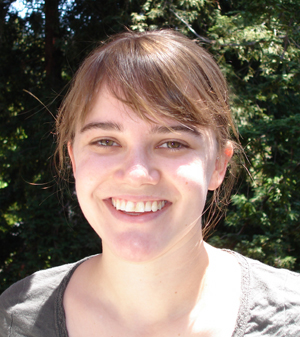 I love physics, but in graduate school my attention started to wander. In
the chemistry lab, I was more interested in reading magazines than in the
organic solvents Iíd spill on them. At conferences, I worried about the
talks I was missing while I presented my own research. I was an
enthusiastic generalist in a specialistís game. After graduate school, I
went to work for the National Academy of Sciences. I thought Iíd become a
liaison between scientists and their financial supporters, but when I was
assigned to write a report for Congress, I found my calling. For me,
distilling complexity through writing is far more challenging and
rewarding than mathematics. Iíd like to tell the stories that
have long distracted me.
I love physics, but in graduate school my attention started to wander. In
the chemistry lab, I was more interested in reading magazines than in the
organic solvents Iíd spill on them. At conferences, I worried about the
talks I was missing while I presented my own research. I was an
enthusiastic generalist in a specialistís game. After graduate school, I
went to work for the National Academy of Sciences. I thought Iíd become a
liaison between scientists and their financial supporters, but when I was
assigned to write a report for Congress, I found my calling. For me,
distilling complexity through writing is far more challenging and
rewarding than mathematics. Iíd like to tell the stories that
have long distracted me.
ABOUT THE ILLUSTRATORS
Melisa Beveridge
B.A., biology and natural history, and B.A., art, University of Montana,
Missoula
I grew up in Ohio surrounded by farmlands, gardens, and orchards. I thought that everyone spent their childhood playing in cornfields and exploring the insects in irrigation ditches. I left home to study fine art, but soon realized that something was missing. After exploring for a few years, my Volkswagen bus decided to strand me in Missoula, Montana, where I quickly developed an appreciation for its hiking trails and rivers to float. When I wasnít playing in the mountains, I turned my love of plants and insects into a gig as an organic farmer. While doing research on chili peppers, I discovered a beautifully illustrated pepper book. I began to understand that I could combine my interests, so I decided to go back to school for biology and finish my art degree. I look forward to integrating these disciplines in hopes of inspiring interest and understanding of the natural world.
Joe Hill
B.S., integrated science and technology, James Madison University
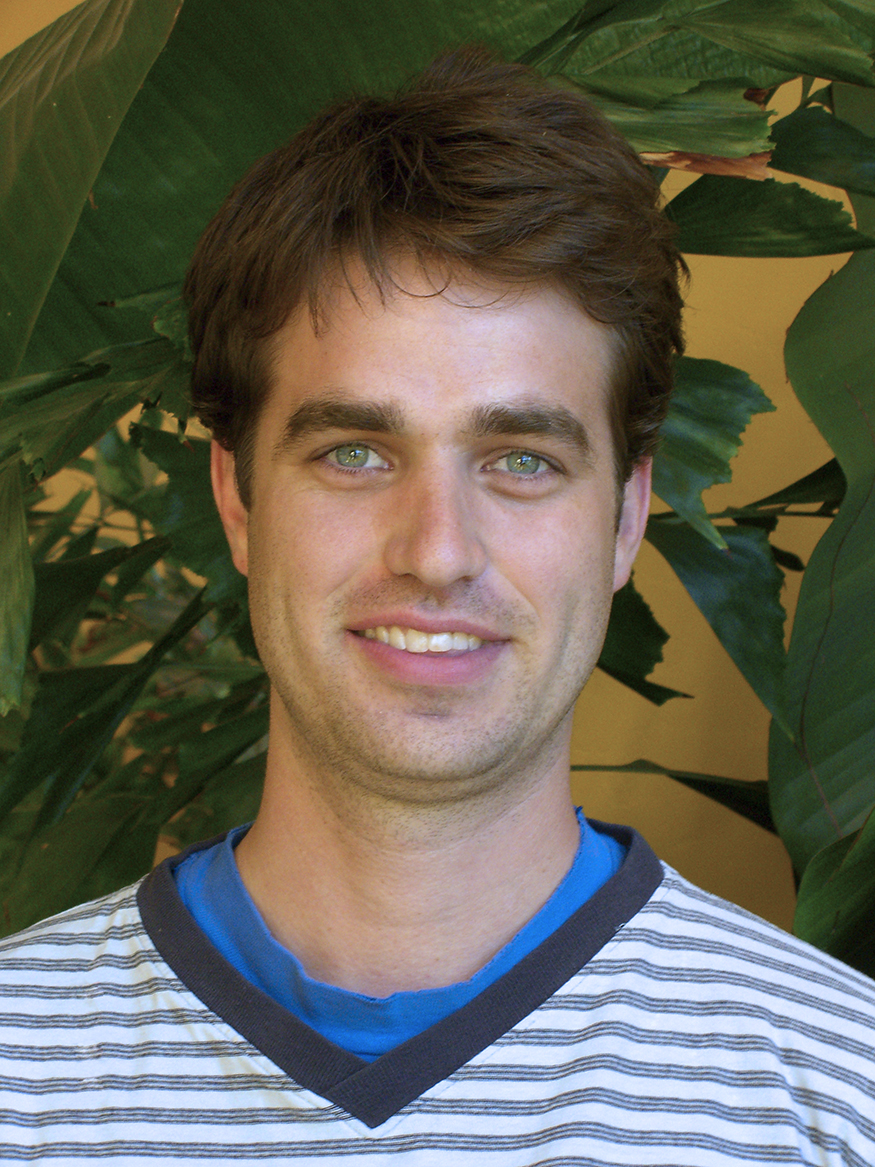 If I had to choose one of the Swiss Family Robinson brothers that I most
closely resembled it would be Francis. The youngest of three, Francis
directed his entire attention towards collecting bugs, monkeys, and
tigers. Iíve never actually caught a tiger, nor have I lived in a tree
house, but I am someone who is continually fascinated by the wonders of
nature. Initially I was drawn in by the density and diversity of wildlife
in the Central Virginia Blue Ridge as a child, and subsequently pulled
toward researching the infinite complexity of the biology displayed in
microscopic worms, yeast, and fruit flies. I now find myself entering a
confluence of Francis-like fascination in science and exploration, and
what I have found to be my most pleasing form of contribution:
illustration.
If I had to choose one of the Swiss Family Robinson brothers that I most
closely resembled it would be Francis. The youngest of three, Francis
directed his entire attention towards collecting bugs, monkeys, and
tigers. Iíve never actually caught a tiger, nor have I lived in a tree
house, but I am someone who is continually fascinated by the wonders of
nature. Initially I was drawn in by the density and diversity of wildlife
in the Central Virginia Blue Ridge as a child, and subsequently pulled
toward researching the infinite complexity of the biology displayed in
microscopic worms, yeast, and fruit flies. I now find myself entering a
confluence of Francis-like fascination in science and exploration, and
what I have found to be my most pleasing form of contribution:
illustration.